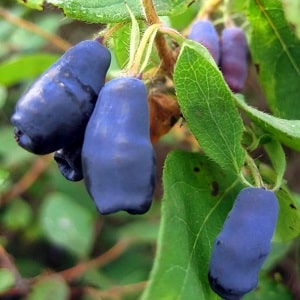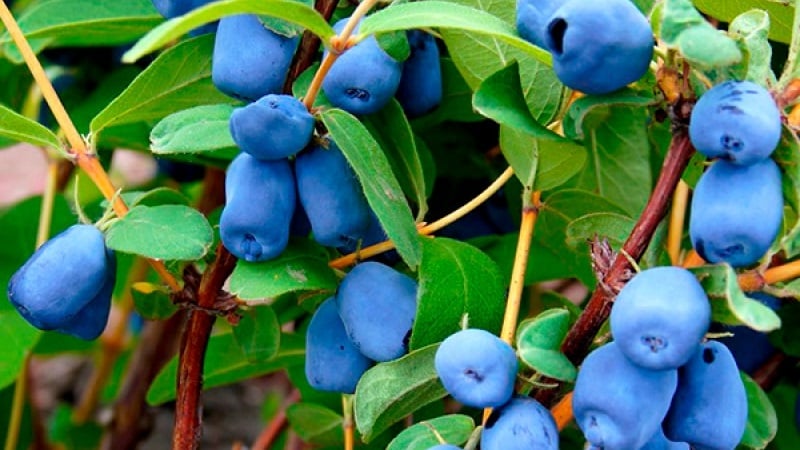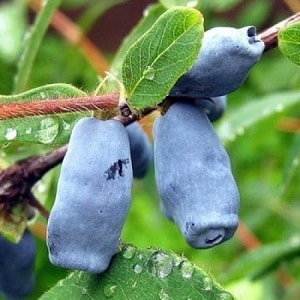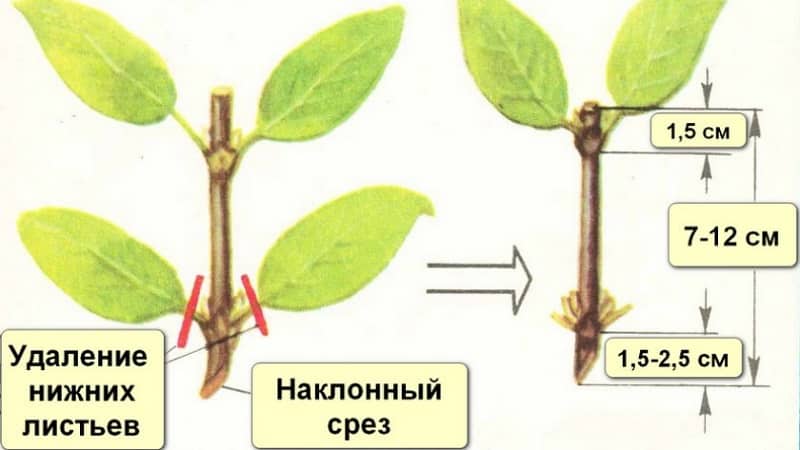Cold-resistant honeysuckle variety Blueberry with sweet and sour fruits
Blueberry is an edible honeysuckle of domestic selection. The bushes are characterized by a decorative appearance, ease of care and high productivity. We will tell you in detail about the characteristics of the variety, its advantages and disadvantages.
Description of the honeysuckle variety Blueberry
100 g of fruit contains up to 37 mg of ascorbic acid, 70 mg of potassium, 35 mg of sodium and phosphorus, 21 mg of magnesium, 0.38 mg of iron, 8.5 g of sugars and up to 810 mg of p-active substances (flavonoids).
Honeysuckle helps strengthen the immune system, it is useful to use for high blood pressure, metabolic disorders and malfunctions of the digestive system.

Breeding history
This variety of edible honeysuckle was developed by Russian breeders in the 80s. XX century. at the South Ural Research Institute of Horticulture and Potato Growing as a result of free pollination of Smolinskaya honeysuckle. It was included in the State Register in 1994.
Characteristics, description of appearance, taste
Medium-sized bushes, no more than 1.5 m in height, moderately spreading, with powerful, thick, erect, slightly curved purple shoots and a dense back-cone-shaped crown.
Leaves are small, light green, lanceolate in shape with thin but noticeable veins. In mid-May, small pale yellow flowers appear on the bushes.
The berries are elongated, slightly flattened reach 2 cm in length and weigh 0.75-1.7 g. Covered with thin blue skin with a layer of waxy coating.
The pulp is sweet and sour, with a delicate aroma and blueberry flavor.
Features of application
The berries are consumed fresh, freeze or dried. Honeysuckle fruits are suitable for processing and preparations: compotes, preserves, jams.
Ripening period, yield and fruiting
Mid-season variety - the harvest ripens in mid-July. The bushes bear fruit within 15-20 days, starting 3-4 years after planting.
Average yield – 45 c/ha, maximum – 57 c/ha.
Resistance to diseases and pests
 Blueberries are resistant to diseases and pests, but if improperly cared for or grown in the wrong place, bushes can infect:
Blueberries are resistant to diseases and pests, but if improperly cared for or grown in the wrong place, bushes can infect:
- powdery mildew;
- brown spot;
- rhubarb mosaic virus;
- spider mites;
- aphid;
- honeysuckle sawfly.
Resistance to cold and drought
Bushes tolerate frosts down to -50°C, young buds and inflorescences can withstand short-term temperature drops to -8°C.
Lack of moisture negatively affects yields crops and the taste of fruits, and excessive watering and waterlogging of the soil lead to rotting of the root system of plants.
Growing regions and climate requirements
The variety prefers warm and temperate climates, but due to its unpretentiousness and high degree of frost resistance, it is suitable for growing in all regions of Russia.
Advantages and disadvantages of the variety
The main advantages of Chernichka:
- abundant yield;
- decorative appearance of bushes;
- high degree of frost resistance;
- attractive appearance, pleasant taste, benefits of fruits;
- lack of tendency for berries to shed after ripening;
- immunity to diseases;
- regular fruiting;
- unpretentiousness.
Disadvantages of the variety:
- the need for pruning;
- need for pollinating varieties;
- the presence of sourness in the taste of berries;
- average fruit size.

Difference from other varieties and hybrids
Comparison of Blueberry with other mid-season honeysuckle varieties presented in the table:
| Variety | Berries shape | Berry weight, g | Taste | Productivity, c/ha |
| Blueberry | Elongated, slightly flattened | 0,75-1,7 | Sweet and sour with blueberry flavor | 45 |
| Highlight | Elongated oval | 1-1,6 | Sweet and sour with spicy notes | 27 |
| Swan | Elongated cylindrical | 1,2-1,6 | Sweet and sour | 40 |
| Malvina | Elongated pear-shaped | 1-1,1 | Sweet and sour | 48,9 |
Agricultural technology
In order for the bushes to develop and bear fruit regularly, the plants are provided with proper care, and the landing site is chosen in accordance with the requirements.
Choosing a place in the garden and preparing holes
The bushes are planted in a lighted place, protected from drafts and cold gusty winds.. The permissible level of groundwater is at least 1.5-2 m from the surface of the earth.
Reference. A lack of light leads to a decrease in yield and a deterioration in the taste of berries, and due to waterlogging of the soil, the roots of the plants rot.
The site is dug deep in advance and cleared of plant debris and weeds.. Add manure or peat if the soil is sandy, lime or dolomite flour into the soil with high acidity.
Soil requirements
The variety prefers loose, fertile, moderately moist, water- and breathable soil. with medium or neutral acidity.
Preparation of seedlings
Seedlings suitable for planting have flexible, intact roots and strong shoots. Immediately before planting on the site, they are inspected, all dry and damaged areas of the root system are cut off, healthy shoots are shortened to 25-30 cm and the roots are soaked for 2-4 hours in a solution of a growth stimulator (Kornevin, Heteroauxin).

Dates, scheme and rules of planting
Blueberries are being planted in spring, late March - early April, or in the fall, before frost begins (in October).
Planting scheme:
- In the prepared area, dig planting holes with a diameter of 60 cm and a depth of 40 cm every 3 m.
- Place a drainage layer of crushed stone or pebbles on the bottom of each.
- Form a hill in the center of the hole from a nutritious soil mixture (dug up soil, 2 buckets of compost, 1 liter of wood ash, 50 g of superphosphate), install a seedling on it, straightening the roots.
- Cover the plants with soil, deepening the root collar by 2 cm.
- Water the plantings at the rate of at least 10 liters of water per 1 seedling.
- Mulch the tree trunk circle with peat or humus.
Features of cultivation
Under favorable weather conditions and sufficient rainfall plants are watered no more than 3 times per season. If the summer is dry, they focus on the condition of the top layer of soil - watering (5-6 buckets of water per bush) is carried out as soon as it is completely dry.
After watering or rain, the soil is loosened to improve its moisture and breathability. At the same time, weeds are removed, which take nutrients from the soil and create favorable conditions for the development of diseases and harmful insects.
 Fertilizers begin to be applied 3-4 years after planting:
Fertilizers begin to be applied 3-4 years after planting:
- early spring – 30 g of ammonium nitrate;
- after flowering - 40 g of superphosphate and potassium salt;
- autumn – 50 g of complex mineral fertilizers (“Ammofos”, “Diammofoska”, “Ammofoska”, “Nitrophoska”).
Within 3 years after planting, formative pruning to give the correct shape to the crown of bushes and prevent the development of diseases and pest attacks. Bushes aged 4 years and older only need annual sanitary and thinning pruning.
2 years after planting the seedlings, all shoots on them are shortened to 30 cm, after 3 years, no more than 5 strong shoots coming from the base are left on the bush; from the 4th year, only branches that grow inside the crown, are underdeveloped or located close to each other are cut off.
At 8-9 years of life of the bush, anti-aging pruning is carried out, removing old and stunted branches.
Reference. Formative, thinning and rejuvenating pruning is carried out in the fall after the leaves fall, sanitary pruning - in March.
Pollinators
Blueberry is a self-sterile variety that requires pollinators to bear fruit.. Therefore, 2-3 other varieties of honeysuckle are planted nearby, matching the flowering period.
The best pollinators for blueberries:
- Enchantress;
- Sweet tooth;
- Berel;
- cubic zirconia
Disease and pest control
Diseases and pests, which can hit Blueberry in case of violation of the rules of care and cultivation, are presented in the table:
| Disease/pest | Description, symptoms | Treatment, prevention |
| Powdery mildew | A white coating similar to flour appears on the leaves and shoots, the affected parts of the bushes become brown, fall off, the shoots become deformed, and the berries do not ripen on time. | Treatment of plants with the drug "Skor". |
| Brown spot | Small brown spots form on the upper part of the leaves, the lower part becomes covered with a white coating. | Infected bushes are treated with HOM or Bordeaux mixture. |
| Rezucha mosaic virus | Small yellow spots appear on the leaves, leaf blades wrinkle, internodes shorten, which leads to the growth of many side shoots. | To eliminate the possibility of the disease spreading, all affected parts of the plants are pruned and destroyed. |
| Spider mite | A thin cobweb appears on the branches, the leaves turn yellow and fall off. | The bushes are treated with the drug "Actellik". |
| Aphid | The shoots become covered with a sticky coating, the leaves become deformed and curled, and the yield decreases. | To combat insects, the drug “Kinmiks” is used. |
| Honeysuckle sawfly | Caterpillars eat leaves and fruit pulp, damage flower buds and ovaries. Plants are stunted, yields are reduced, and berries rot. | Honeysuckle is treated with Inta-Vir. |
Preparing for winter
Only young plants need protection from frost.. At the end of autumn they are covered with spruce branches.
Otherwise preparing honeysuckle for winter consists of cleaning the tree trunk circle from debris and plant remains, mulching the ground around the bushes with peat and tying branches and shoots with a special net that protects the plants from rodents.
Reproduction
Blueberries are propagated vegetatively – by cuttings or dividing the bush.
You can root cuttings several times per season.:
- Late March – early April. From branches 7-8 mm thick, cuttings 15-17 cm long are cut, the cut area is treated with “Kornevin” and planted in the ground at an angle, deepening it to about 10 cm so that at least 2 buds remain on top.
- After flowering. Annual shoots with fresh growth are used as cuttings. They are planted to a depth of 5-7 cm.
- At the end of June. For propagation, green cuttings are used, which are cut off with the apical bud and planted in the ground, buried 10 cm.

The bush division method is only suitable for plants over 8 years old. The bush is dug out of the ground and divided into several parts so that each has at least 3 shoots and a part of the rhizome at least 40 cm long.
Reference. When propagated by seed, the plant does not inherit varietal characteristics.
Difficulties in growing
Problems you may encounter when growing blueberries:
- the yield is low, the berries are small and sour - the bushes grow in the shade, they lack light;
- a white coating has appeared on the bushes, the berries do not ripen or ripen late - symptoms of powdery mildew;
- the bushes do not develop, deteriorate and die - signs of rotting roots due to excessive watering or the proximity of groundwater.
Harvesting
Harvest begins in mid-July. The berries ripen unevenly, so picking is carried out in several stages, focusing on the ripeness of the fruit, which should turn blue.
The berries are picked by hand or the bush is shaken, having previously spread a film under it or fabric on which the honeysuckle will fall.
The harvested crop is sorted and inspected. Only elastic berries without cracks or rot are suitable for storage. They are placed in a dry, shallow container and stored in a dark, cool (about 0°C) place. In such conditions, the crop is stored for up to 5 days. Damaged specimens are discarded or set aside for consumption.
Tips and reviews from experienced gardeners
Experienced gardeners recommend:
- to minimize the risk of disease and pests, spray the bushes with a solution of Bordeaux mixture before flowering;
- mulch the soil with humus or manure to retain moisture and prevent weed growth.

Gardeners speak positively about the variety.
Maria, Lodeynoye Pole: “Blueberry has valuable advantages - frost resistance and immunity to disease. But most of all I like the taste of the berries - sweet, with a slight sourness and a hint of blueberries. The whole family loves it".
Elena, Moscow region: “Blueberries have been growing on my plot for a long time.In the first years there was no harvest, but now I can’t get enough of it – there are a lot of berries, they are tasty and healthy. The bushes have never gotten sick, and this despite the fact that I don’t do preventive treatments.”.
Conclusion
Blueberry is an unpretentious variety of honeysuckle that even novice gardeners can grow. Among its advantages are abundant yield, frost resistance, immunity, high commercial quality and pleasant taste of the fruit.